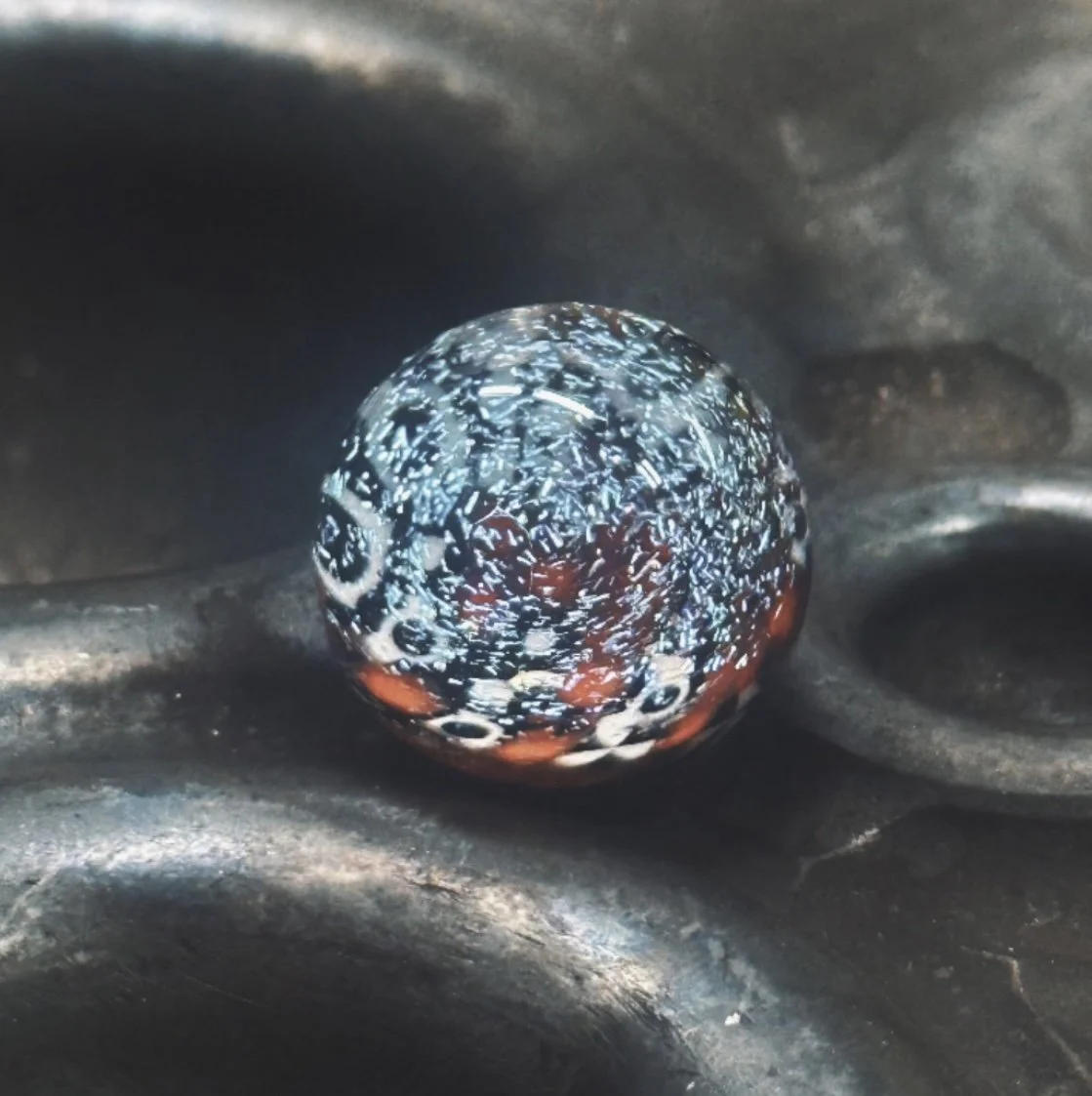Dichroic Glass: Trapping Explosive Fireworks in Liquid Glass
Monarch Milli V.2 DIchroic Glass Marble
The marble features a vibrant blend of orange and yellow hues with striking black accents, arranged in a pattern reminiscent of a monarch butterfly's wings. Encased in clear glass, the design is enhanced by a dichroic firework effect, creating shimmering, iridescent flashes that shift with the light, adding depth and brilliance to the intricate pattern.
Made by resident artist 904PizzaBoy*
The Mystical World of Dichroic Glass in Borosilicate Art: A Fusion of Chemistry and Creativity
Glass art has always held a special kind of magic—a blend of science and creativity that transforms simple sand into mesmerizing artworks. Among the most captivating materials in this realm is dichroic glass, especially when fused with borosilicate glass. This combination brings an alchemical touch to contemporary glass art, rooted in fascinating chemistry yet accessible and awe-inspiring.
What Is Dichroic Glass?
Dichroic glass is a type of glass that shows two different colors when viewed from different angles or under different lighting conditions. This optical trick is not due to pigments or dyes but rather to the way light interacts with microscopic layers of metal oxides deposited on the glass surface.
The Chemistry Behind the Color Shift
At the heart of dichroic glass’s magic is a process called thin-film interference. During production, multiple ultra-thin layers—only a few atoms thick—of metal oxides such as titanium, silicon, and magnesium are vaporized in a vacuum chamber and deposited onto the surface of clear glass. These layers are so thin that when light hits the glass, some wavelengths of light are amplified while others are canceled out, depending on the viewing angle.
Imagine light as waves. When it hits these metal oxide layers, some waves overlap and strengthen, while others cancel out, creating a shifting palette of colors that seem to dance and change—almost like a secret code written in light itself.
Borosilicate Glass: The Resistant Canvas
Borosilicate glass, often used in laboratory equipment and high-quality cookware, is prized for its durability and resistance to thermal shock. Unlike ordinary glass, borosilicate can withstand rapid temperature changes, making it perfect for intricate art pieces that require heating and cooling during the shaping process.
When artisans use borosilicate as a base to incorporate dichroic glass, they’re working with a rock-solid canvas that can be melted, stretched, and sculpted without worry of cracking, all while bringing the shimmering, ethereal colors of dichroic layers to life.
A Historical Glimpse
While dichroic glass might sound like a modern invention, its roots trace back to the mid-20th century and earlier glass experiments. The term "dichroic," meaning "showing two colors," aligns with ancient techniques where artisans created iridescent effects in glass, such as the famous Lycurgus Cup from Roman times, known for its color-changing properties depending on light.
Modern dichroic glass, however, truly emerged in the 1950s with advancements in space technology—NASA notably developed thin-film coatings with dichroic properties for satellites and optical instruments. Artists soon adapted these scientific innovations, applying them in small-scale glass pieces, especially borosilicate, due to its robust nature.
How Artists Use Dichroic Borosilicate Glass Today
Today’s borosilicate artists layer, embed, and coat their creations with dichroic glass to produce effects that seem almost otherworldly. The pieces are dynamic: as the viewer moves, the glass reveals a kaleidoscope of hues, highlighting the interplay between light, color, and form.
From delicate beads and pendants to intricate sculptures, dichroic borosilicate glass bridges the gap between pure science and creative expression.
The Alchemy in the Studio
Creating dichroic glass art is like practicing a modern form of alchemy. Artists must understand not only how heat affects borosilicate glass but also how light will interact with the thin-film coatings—often invisible until illuminated perfectly.
The delicate layering requires precision and experience:
Fusing layers must be done at specific temperatures to prevent the metal oxide layers from degrading.
Annealing—a controlled cooling phase—is crucial to ensure strength without losing sheen.
Polishing and shaping can enhance or obscure the dichroic effects, giving each piece unique reflective properties.
This blend of chemistry and craftsmanship allows glass artists to create works that feel alive, shifting with light like a treasure chest full of secrets waiting to be discovered.
Why Does Dichroic Glass Fascinate Us?
Part of dichroic glass's allure is its mystery—how can something so carefully layered with invisible metal oxides produce such vivid, changing colors? It’s an intersection of science, art, and a touch of enchantment. This “science as magic” is what draws both artists and enthusiasts alike.
In the end, dichroic borosilicate glass art invites us to see the world through a prism of curiosity, color, and chemistry—a dazzling reminder that even our most advanced scientific techniques still hold wonder and mystery.
Whether you’re an artist, scientist, or simply a lover of beautiful things, understanding the chemistry behind dichroic borosilicate glass unlocks a new appreciation

